An Assessment of Stress States in Passive Margin Sediments: Iterative Hydro-Mechanical Simulations on Basin Models and Implications for Rock Failure Predictions
Abstract
1. Introduction
2. Observations
3. Simulation Strategy
3.1. Traditional Approaches
3.2. Iterative Hydro-Mechanical Coupling
3.3. Rheology
4. Set of Synthetic Basin Models
4.1. Design
4.1.1. Geological Setting
4.1.2. Common Features
4.1.3. Variations between Models
4.2. Present-Day Grids
4.3. Past Geometries
4.4. Simulation Parameters
4.4.1. Mechanical Properties
4.4.2. Permeability
4.4.3. Boundary Conditions
5. Simulation Results
5.1. Pore Pressure and Porosity
5.2. Stress States
5.2.1. Shear Stress and Rotation of Principal Stresses
5.2.2. Extension and Compression
5.3. Failure Preconditioning
5.3.1. Weakness Prediction
5.3.2. Influence of Sedimentation Rate
5.3.3. Influence of Subsidence Tilt
6. Conclusions and Perspectives
6.1. Stress States in Passive Margin Sediments
6.2. Geological Control on Rock Failure Preconditioning
6.3. Modelling Hypotheses and Way Forward
6.4. Integration of Non-Vertical Stresses in Basin Simulators
Author Contributions
Funding
Acknowledgments
Conflicts of Interest
Appendix A. Petro-Physical Properties of the Modelled Lithological Facies

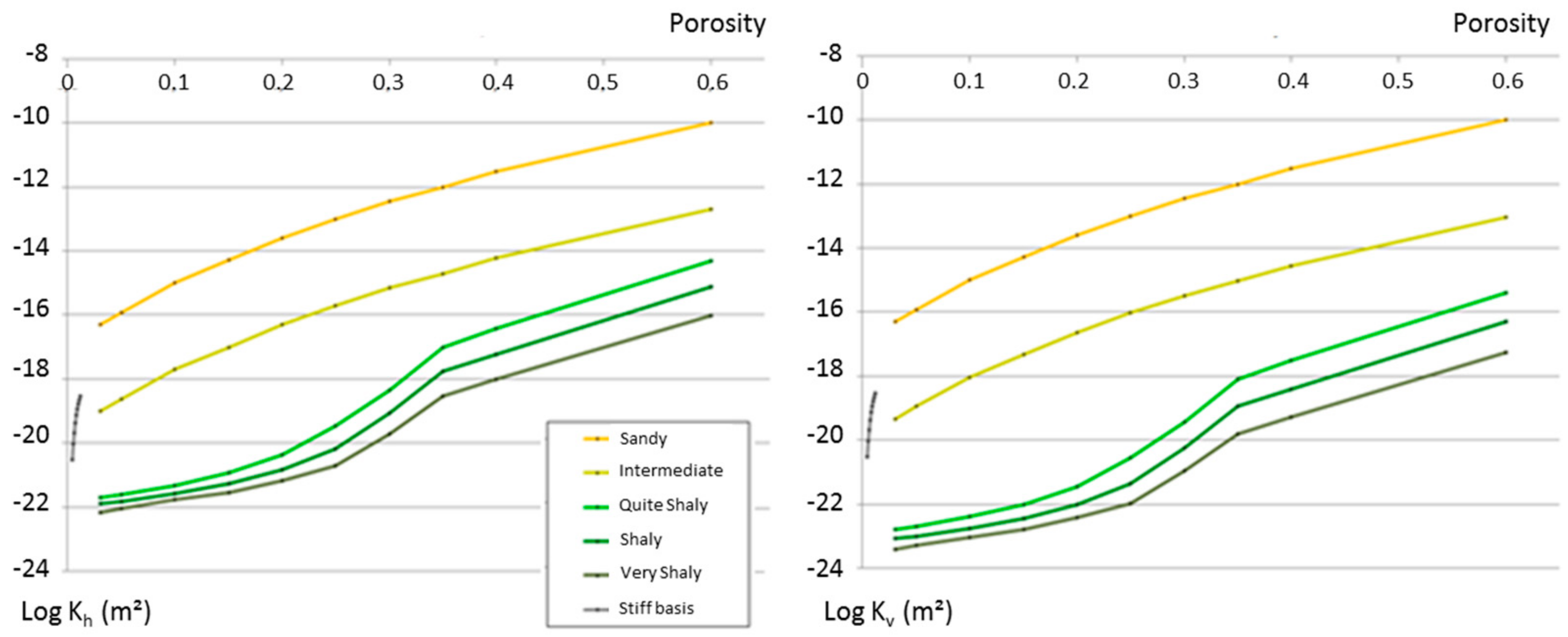
References
- Bradley, D.C. Passive margins through earth history. Earth Sci. Rev. 2008, 91, 1–26. [Google Scholar] [CrossRef]
- Levell, B.; Argent, J.; Doré, A.G.; Fraser, S. Passive margins: Overview. In Geological Society, London, Petroleum Geology Conference Series; Geological Society of London: London, UK, 2011; Volume 7, pp. 823–830. [Google Scholar] [CrossRef]
- Wen, Z.; Xu, H.; Wang, Z.; He, Z.; Song, C.; Chen, X.; Wang, Y. Classification and hydrocarbon distribution of passive continental margin basins. Pet. Explor. Dev. 2016, 43, 740–750. [Google Scholar] [CrossRef]
- Mann, P.; Gahagan, L.; Gordon, M.B. Tectonic setting of the world’s giant oil and gas fields. In Giant Oil and Gas Fields of the Decade 1990–1999, AAPG Memoir; American Association of Petroleum Geologists: Tulsa, OK, USA, 2003; Volume 78, pp. 15–105. [Google Scholar] [CrossRef]
- Canals, M.; Lastras, G.; Urgeles, R.; Casamor, J.L.; Mienert, J.; Cattaneo, A.; De Batist, M.; Haflidason, H.; Imbo, Y.; Laberg, J.; et al. Slope failure dynamics and impacts from seafloor and shallow sub-seafloor geophysical data: case studies from the COSTA project. Mar. Geol. 2004, 213, 9–72. [Google Scholar] [CrossRef]
- Vanneste, M.; Sultan, N.; Garziglia, S.; Forsberg, C.F.; L’Heureux, J.-S. Seafloor instabilities and sediment deformation processes: The need for integrated, multi-disciplinary investigations. Mar. Geol. 2014, 352, 183–214. [Google Scholar] [CrossRef]
- Stow, D.A.; Johansson, M. Deep-water massive sands: nature, origin and hydrocarbon implications. Mar. Pet. Geol. 2000, 17, 145–174. [Google Scholar] [CrossRef]
- Shanmugam, G. New perspectives on deep-water sandstones: Implications. Pet. Explor. Dev. 2013, 40, 316–324. [Google Scholar] [CrossRef]
- Magara, K. Compaction and Fluid Migration; Elsevier: Amsterdam, The Netherlands, 1978; Volume 9, ISBN 0-444-41654-4. [Google Scholar]
- Du Rouchet, J. Stress Fields, A Key to Oil Migration. AAPG Bull. 1981, 65, 74–85. [Google Scholar]
- Zhang, J. Effective stress, porosity, velocity and abnormal pore pressure prediction accounting for compaction disequilibrium and unloading. Mar. Pet. Geol. 2013, 45, 2–11. [Google Scholar] [CrossRef]
- Li, S.; George, J.; Purdy, C. Pore-Pressure and Wellbore-Stability Prediction to Increase Drilling Efficiency. J. Pet. Technol. 2012, 64, 98–101. [Google Scholar] [CrossRef]
- Faille, I.; Thibaut, M.; Cacas, M.-C.; Havé, P.; Willien, F.; Wolf, S.; Agelas, L.; Pegaz-Fiornet, S. Modeling Fluid Flow in Faulted Basins. Oil Gas Sci. Technol. Rev. l’IFP 2014, 69, 529–553. [Google Scholar] [CrossRef]
- Available online: https://www.code-aster.org (accessed on 18 October 2019).
- Watts, A. Models for the evolution of passive margins. In Regional Geology and Tectonics: Phanerozoic Rift Systems and Sedimentary Basins; Elsevier: Amsterdam, The Netherlands, 2012; Volume 1, pp. 32–57. [Google Scholar]
- Catuneanu, O. Principles of Sequence Stratigraphy; Elsevier: Amsterdam, The Netherlands, 2006; ISBN 978-0-444-51568-1. [Google Scholar]
- O’Grady, D.B.; Syvitski, J.P.M.; Pratson, L.F.; Sarg, J.F. Categorizing the morphologic variability of siliciclastic passive continental margins. Geology 2000, 28, 207. [Google Scholar] [CrossRef]
- Dugan, B.; Sheahan, T.C. Offshore sediment overpressures of passive margins: Mechanisms, measurement, and models. Rev. Geophys. 2012, 50. [Google Scholar] [CrossRef]
- Osborne, M.J.; Swarbrick, R.E. Mechanisms for Generating Overpressure in Sedimentary Basins: A Reevaluation. AAPG Bull. 1997, 81, 1023–1041. [Google Scholar]
- Grauls, D. Overpressures: Causal Mechanisms, Conventional and Hydromechanical Approaches. Oil Gas Sci. Technol. Rev. l’IFP 1999, 54, 667–678. [Google Scholar] [CrossRef]
- Shaker, S. Sequence stratigraphy: Key to geopressure profile assessment. CSEG Rec. 2002, 9, 88–91. Available online: https://csegrecorder.com/articles/view/sequence-stratigraphy-key-to-geopressure-profile-assessment (accessed on 5 November 2019).
- Flemings, P.B. Flow focusing in overpressured sandstones: Theory, observations, and applications. Am. J. Sci. 2002, 302, 827–855. [Google Scholar] [CrossRef]
- Xie, X.; Li, S.; Dong, W.; Zhang, Q. Overpressure development and hydrofracturing in the Yinggehai basin, South China Sea. J. Pet. Geol. 1999, 22, 437–454. [Google Scholar] [CrossRef]
- Hustoft, S.; Mienert, J.; Bünz, S.; Nouzé, H. High-resolution 3D-seismic data indicate focussed fluid migration pathways above polygonal fault systems of the mid-Norwegian margin. Mar. Geol. 2007, 245, 89–106. [Google Scholar] [CrossRef]
- Hampton, M.A.; Lee, H.J.; Locat, J. Submarine landslides. Rev. Geophys. 1996, 34, 33–59. [Google Scholar] [CrossRef]
- Wynn, R.B.; Kenyon, N.H.; Weaver, P.P.E.; Evans, J. Continental margin sedimentation, with special reference to the north-east Atlantic margin. Sedimentology 2000, 47, 239–256. [Google Scholar]
- Hühnerbach, V.; Masson, D.; Costa-Project, P.O.T. Landslides in the North Atlantic and its adjacent seas: an analysis of their morphology, setting and behaviour. Mar. Geol. 2004, 213, 343–362. [Google Scholar] [CrossRef]
- Krastel, S.; Lehr, J.; Winkelmann, D.; Schwenk, T.; Preu, B.; Strasser, M.; Wynn, R.B.; Georgiopoulou, A.; Hanebuth, T.J.J. Mass wasting along Atlantic continental margins: A comparison between NW-Africa and the de la Plata River region (northern Argentina and Uruguay). In Submarine Mass Movements and Their Consequences; Springer: Cham, Switzerland, 2014; pp. 459–469. [Google Scholar] [CrossRef]
- Le Bouteiller, P.; Lafuerza, S.; Charléty, J.; Reis, A.T.; Granjeon, D.; Delprat-Jannaud, F.; Gorini, C. A new conceptual methodology for interpretation of mass transport processes from seismic data. Mar. Pet. Geol. 2019, 103, 438–455. [Google Scholar] [CrossRef]
- Camargo, J.M.; Silva, M.V.; Ferreira Júnior, A.V.; Araújo, T. Marine Geohazards: A Bibliometric-Based Review. Geosciences 2019, 9, 100. [Google Scholar] [CrossRef]
- Rowan, M.G.; Peel, F.J.; Vendeville, B.C. Gravity-driven fold belts on passive margins, In Thrust Tectonics and Hydrocarbon Systems. AAPG Memoir 2004, 82, 157–182. [Google Scholar] [CrossRef]
- Morley, C.; King, R.; Hillis, R.; Tingay, M.; Backé, G.; Morley, C. Deepwater fold and thrust belt classification, tectonics, structure and hydrocarbon prospectivity: A review. Earth Sci. Rev. 2011, 104, 41–91. [Google Scholar] [CrossRef]
- Locat, J.; Leroueil, S.; Locat, A.; Lee, H. Weak layers: Their definition and classification from a geotechnical perspective. In Submarine Mass Movements and Their Consequences; Springer: Cham, Switzerland, 2014; pp. 3–12. [Google Scholar] [CrossRef]
- Dugan, B. Flemings Overpressure and fluid flow in the new jersey continental slope: implications for slope failure and cold seeps. Science 2000, 289, 288–291. [Google Scholar] [CrossRef]
- Sultan, N.; Cochonat, P.; Canals, M.; Cattaneo, A.; Dennielou, B.; Haflidason, H.; Laberg, J.; Long, D.; Mienert, J.; Trincardi, F.; et al. Triggering mechanisms of slope instability processes and sediment failures on continental margins: a geotechnical approach. Mar. Geol. 2004, 213, 291–321. [Google Scholar] [CrossRef]
- Behrmann, J.H.; Flemings, P.B.; John, C.M. Rapid Sedimentation, Overpressure, and Focused Fluid Flow, Gulf of Mexico Continental Margin. Sci. Drill. 2006, 3, 12–17. [Google Scholar] [CrossRef]
- Urgeles, R.; Locat, J.; Dugan, B. Recursive Failure of the Gulf of Mexico Continental Slope: Timing and Causes. In Submarine Mass Movements and Their Consequences; Springer: Dordrecht, The Netherlands, 2007; pp. 209–219. [Google Scholar] [CrossRef]
- Wolinsky, M.A.; Pratson, L.F. Overpressure and slope stability in prograding clinoforms: Implications for marine morphodynamics. J. Geophys. Res. Space Phys. 2007, 112. [Google Scholar] [CrossRef]
- Ai, F.; Strasser, M.; Preu, B.; Hanebuth, T.J.J.; Krastel, S.; Kopf, A. New constraints on oceanographic vs. seismic control on submarine landslide initiation: a geotechnical approach off Uruguay and northern Argentina. Geo-Mar. Lett. 2014, 34, 399–417. [Google Scholar] [CrossRef]
- Xie, X.; Müller, R.D.; Ren, J.; Jiang, T.; Zhang, C. Stratigraphic architecture and evolution of the continental slope system in offshore Hainan, northern South China Sea. Mar. Geol. 2008, 247, 129–144. [Google Scholar] [CrossRef]
- Mauduit, T.; Guerin, G.; Brun, J.-P.; Lecanu, H. Raft tectonics: the effects of basal slope angle and sedimentation rate on progressive extension. J. Struct. Geol. 1997, 19, 1219–1230. [Google Scholar] [CrossRef]
- Mourgues, R.; Lacoste, A.; Garibaldi, C. The Coulomb critical taper theory applied to gravitational instabilities. J. Geophys. Res. Solid Earth 2014, 119, 754–765. [Google Scholar] [CrossRef]
- Brun, J.-P.; Fort, X. Salt tectonics at passive margins: Geology versus models. Mar. Pet. Geol. 2011, 28, 1123–1145. [Google Scholar] [CrossRef]
- Yuan, X.P.; Leroy, Y.M.; Maillot, B. Reappraisal of gravity instability conditions for offshore wedges: Consequences for fluid overpressures in the Niger Delta. Geophys. J. Int. 2017, 208, 1655–1671. [Google Scholar] [CrossRef]
- Dahlen, F.A. Noncohesive critical Coulomb wedges: An exact solution. J. Geophys. Res. Space Phys. 1984, 89, 10125–10133. [Google Scholar] [CrossRef]
- Leynaud, D.; Sultan, N.; Mienert, J. The role of sedimentation rate and permeability in the slope stability of the formerly glaciated Norwegian continental margin: The Storegga slide model. Landslides 2007, 4, 297–309. [Google Scholar] [CrossRef]
- Sultan, N.; Gaudin, M.; Berné, S.; Canals, M.; Urgeles, R.; Lafuerza, S. Analysis of slope failures in submarine canyon heads: An example from the Gulf of Lions. J. Geophys. Res. Space Phys. 2007, 112, 1–29. [Google Scholar] [CrossRef]
- Dan, G.; Sultan, N.; Savoye, B.; Deverchere, J.; Yelles, K. Quantifying the role of sandy–silty sediments in generating slope failures during earthquakes: Example from the Algerian margin. Int. J. Earth Sci. 2009, 98, 769–789. [Google Scholar] [CrossRef]
- Urlaub, M.; Zervos, A.; Talling, P.J.; Masson, D.G.; Clayton, C.I. How do ~2° slopes fail in areas of slow sedimentation? A sensitivity study on the influence of accumulation rate and permeability on submarine slope stability. In Submarine Mass Movements and Their Consequences; Springer: Dordrecht, The Netherlands, 2012; pp. 277–287. [Google Scholar] [CrossRef]
- Ai, F.; Kuhlmann, J.; Huhn, K.; Strasser, M.; Kopf, A. Submarine slope stability assessment of the central Mediterranean continental margin: The Gela Basin. In Submarine Mass Movements and their Consequences; Springer: Cham, Switzerland, 2014; pp. 225–236. [Google Scholar] [CrossRef]
- Yuan, X.P.; Leroy, Y.M.; Maillot, B. Tectonic and gravity extensional collapses in overpressured cohesive and frictional wedges. J. Geophys. Res. Solid Earth 2015, 120, 1833–1854. [Google Scholar] [CrossRef]
- Berthelon, J.; Yuan, X.; Bouziat, A.; Souloumiac, P.; Pubellier, M.; Cornu, T.; Maillot, B. Mechanical restoration of gravity instabilities in the Brunei margin, N.W. Borneo. J. Struct. Geol. 2018, 117, 148–162. [Google Scholar] [CrossRef]
- Rudkiewicz, J.L.; Penteado, H.D.B.; Vear, A.; Vandenbroucke, M.; Brigaud, F.; Wendebourg, J.; Duppenbecker, S. Integrated Basin Modeling Helps to Decipher Petroleum Systems. In Petroleum Systems of South Atlantic Margins. AAPG Memoir 2000, 73, 27–40. [Google Scholar] [CrossRef]
- Schneider, F.; Wolf, S.; Faille, I.; Pot, D. A 3d Basin Model for Hydrocarbon Potential Evaluation: Application to Congo Offshore. Oil Gas Sci. Technol. Rev. l’IFP 2000, 55, 3–13. [Google Scholar] [CrossRef]
- Xie, X.; Bethke, C.M.; Li, S.; Liu, X.; Zheng, H. Overpressure and petroleum generation and accumulation in the Dongying Depression of the Bohaiwan Basin, China. Geofluids 2001, 1, 257–271. [Google Scholar] [CrossRef]
- Tuncay, K.; Ortoleva, P. Quantitative basin modeling: present state and future developments towards predictability. Geofluids 2004, 4, 23–39. [Google Scholar] [CrossRef]
- Hantschel, T.; Kauerauf, A.I. Fundamentals of Basin and Petroleum Systems Modeling; Springer Science & Business Media: Berlin/Heidelberg, Germany, 2009. [Google Scholar] [CrossRef]
- Thibaut, M.; Jardin, A.; Faille, I.; Willien, F.; Guichet, X. Advanced Workflows for Fluid Transfer in Faulted Basins. Oil Gas Sci. Technol. Rev. l’IFP 2014, 69, 573–584. [Google Scholar] [CrossRef]
- Fjeldskaar, W.; Andersen, Å.; Johansen, H.; Lander, R.; Blomvik, V.; Skurve, O.; Michelsen, J.K.; Grunnaleite, I.; Mykkeltveit, J.; Mykkeltveit, J. Bridging the gap between basin modelling and structural geology. Reg. Geol. Metallog 2017, 72, 65–77. [Google Scholar]
- Crook, A.J.; Obradors-Prats, J.; Somer, D.; Peric, D.; Lovely, P.; Kacewicz, M. Towards an integrated restoration/forward geomechanical modelling workflow for basin evolution prediction. Oil Gas Sci. Technol. Rev. l’IFP 2018, 73, 18. [Google Scholar] [CrossRef]
- Burgreen-Chan, B.; Meisling, K.E.; Graham, S. Basin and petroleum system modelling of the East Coast basin, New Zealand: A test of overpressure scenarios in a convergent margin. Basin Res. 2016, 28, 536–567. [Google Scholar] [CrossRef]
- Woillez, M.N.; Souque, C.; Rudkiewicz, J.L.; Willien, F.; Cornu, T. Insights in fault flow behavior from onshore Nigeria petroleum system modelling. Oil Gas Sci. Technol. Rev. d’IFP Energies Nouvelles 2017, 72, 31. [Google Scholar] [CrossRef]
- Schneider, F.; Bouteca, M.; Sarda, J.P. Hydraulic Fracturing at Sedimentary Basin Scale. Oil Gas Sci. Technol. Rev. l’IFP 1999, 54, 797–806. [Google Scholar] [CrossRef]
- Hauser, M.R.; Couzens-Schultz, B.A.; Chan, A.W. Estimating the influence of stress state on compaction behavior. Geophysics 2014, 79, D389–D398. [Google Scholar] [CrossRef]
- Prats, J.O.; Rouainia, M.; Aplin, A.C.; Crook, A.J. Stress and pore pressure histories in complex tectonic settings predicted with coupled geomechanical-fluid flow models. Mar. Pet. Geol. 2016, 76, 464–477. [Google Scholar] [CrossRef]
- Tuncay, K.; Park, A.; Ortoleva, P. Sedimentary basin deformation: an incremental stress approach. Tectonophysics 2000, 323, 77–104. [Google Scholar] [CrossRef]
- Obradors-Prats, J.; Rouainia, M.; Aplin, A.C.; Crook, A.J. Assessing the implications of tectonic compaction on pore pressure using a coupled geomechanical approach. Mar. Pet. Geol. 2017, 79, 31–43. [Google Scholar] [CrossRef]
- Campher, C.; Kuhlmann, G.; Adams, S.; Anka, Z.; Di Primio, R.; Horsfield, B. 3D petroleum systems modelling within a passive margin setting, orange basin, blocks 3/4, offshore south Africa—Implications for gas generation, migration and leakage. S. Afr. J. Geol. 2011, 114, 387–414. [Google Scholar]
- Ducros, M.; Carpentier, B.; Wolf, S.; Cacas, M.C. Integration of biodegradation and migration of hydrocarbons in a 2D petroleum systems model: Application to the Potiguar Basin, NE Brazil. J. Pet. Geol. 2016, 39, 61–78. [Google Scholar] [CrossRef]
- Barabasch, J.; Ducros, M.; Hawie, N.; Daher, S.B.; Nader, F.H.; Littke, R. Integrated 3D forward stratigraphic and petroleum system modeling of the Levant Basin, Eastern Mediterranean. Basin Res. 2019, 31, 228–252. [Google Scholar] [CrossRef]
- Guy, N.; Colombo, D.; Frey, J.; Cornu, T.; Cacas-Stentz, M.C. Coupled Modeling of Sedimentary Basin and Geomechanics: A Modified Drucker–Prager Cap Model to Describe Rock Compaction in Tectonic Context. Rock Mech. Rock Eng. 2019, 52, 3627–3643. [Google Scholar] [CrossRef]
- Morency, C.; Huismans, R.S.; Beaumont, C.; Fullsack, P. A numerical model for coupled fluid flow and matrix deformation with applications to disequilibrium compaction and delta stability. J. Geophys. Res. Space Phys. 2007, 112, 1–25. [Google Scholar] [CrossRef]
- Mainguy, M.; Longuemare, P. Coupling Fluid Flow and Rock Mechanics: Formulations of the Partial Coupling Between Reservoir and Geomechanical Simulators. Oil Gas Sci. Technol. Rev. l’IFP 2002, 57, 355–367. [Google Scholar] [CrossRef]
- Guy, N.; Enchéry, G.; Renard, G. Numerical Modeling of Thermal EOR: Comprehensive Coupling of an AMR-Based Model of Thermal Fluid Flow and Geomechanics. Oil Gas Sci. Technol. Rev. l’IFP 2012, 67, 1019–1027. [Google Scholar] [CrossRef]
- Guy, N.; Colombo, D.; Frey, J.; Vincke, O.; Gout, C. Method for Exploitation of Hydrocarbons from a Sedimentary Basin by Means of a Basin Simulation Taking Account of Geomechanical Effects. U.S. Patent No. 10296679, 19 December 2016. [Google Scholar]
- Schneider, F.; Potdevin, J.L.; Wolf, S.; Faille, I. Elastoplastic and Viscoplastic Compaction Model for the Simulation of Sedimentary Basins. Oil Gas Sci. Technol. 1994, 49, 141–148. [Google Scholar] [CrossRef]
- Schneider, F.; Potdevin, J.; Wolf, S.; Faille, I. Mechanical and chemical compaction model for sedimentary basin simulators. Tectonophysics 1996, 263, 307–317. [Google Scholar] [CrossRef]
- Zhang, K.; Zhou, H.; Shao, J. An Experimental Investigation and an Elastoplastic Constitutive Model for a Porous Rock. Rock Mech. Rock Eng. 2013, 46, 1499–1511. [Google Scholar] [CrossRef]
- Brüch, A.; Maghous, S.; Ribeiro, F.; Dormieux, L. A thermo-poro-mechanical constitutive and numerical model for deformation in sedimentary basins. J. Pet. Sci. Eng. 2018, 160, 313–326. [Google Scholar] [CrossRef]
- Pinheiro-Moreira, J.L.; Nalpas, T.; Joseph, P.; Guillocheau, F. Stratigraphie sismique de la marge éocène du Nord du bassin de Santos (Brésil): Relations plate-forme/systèmes turbiditiques; distorsion des séquences de dépôt. Comptes Rendus Acad. Sci. Ser. IIA Earth Planet. Sci. 2001, 332, 491–498. [Google Scholar] [CrossRef]
- Dingle, R.V. Continental margin subsidence: A Comparison between the east and west coasts of Africa. In Reflection Seismology: A Global Perspective; American Geophysical Union (AGU): Washington, DC, USA, 1982; Volume 6, pp. 59–71. [Google Scholar]
- Stow, D.A.V.; Tabrez, A.R. Hemipelagites: Processes, Facies and Model; Geological Society: London, UK, 1998; Volume 129, pp. 317–337. [Google Scholar]
- Perrier, R.; Quiblier, J. Thickness changes in sedimentary layers during compaction history; methods for quantitative evaluation. AAPG Bull. 1974, 58, 507–520. [Google Scholar] [CrossRef]
- Allen, P.A.; Allen, J.R. Basin Analysis: Principles and Application to Petroleum Play Assessment; John Wiley & Sons: Hoboken, NJ, USA, 2013; ISBN 978-0-470-67377-5. [Google Scholar]
- Available online: http://www.beicip.com/petroleum-system-assessment (accessed on 18 October 2019).
- Manger, G.E. Porosity and Bulk Density of Sedimentary Rocks; Bulletin (US Geological Survey), 1144-E; U.S. Government Publishing Office: Washington, DC, USA, 1963; pp. 1–55. [CrossRef]
- Gerçek, H. Poisson’s ratio values for rocks. Int. J. Rock Mech. Min. Sci. 2007, 44, 1–13. [Google Scholar] [CrossRef]
- Mondol, N.H.; Castagna, T.P.C.J. Porosity and permeability development in mechanically compacted silt-kaolinite mixtures. In SEG Technical Program Expanded Abstracts 2009; Society of Exploration Geophysicists: Tulsa, OK, USA, 2009; pp. 2139–2143. [Google Scholar]
- Yang, Y.; Aplin, A.C. A permeability–porosity relationship for mudstones. Mar. Pet. Geol. 2010, 27, 1692–1697. [Google Scholar] [CrossRef]
- Chilingar, G.V. Relationship Between Porosity, Permeability, and Grain-Size Distribution of Sands and Sandstones. In Developments in Sedimentology; Elsevier: Amsterdam, The Netherlands, 1964; Volume 1, pp. 71–75. [Google Scholar]
- Doyen, P.M. Permeability, conductivity, and pore geometry of sandstone. J. Geophys. Res. Space Phys. 1988, 93, 7729. [Google Scholar] [CrossRef]
- Luijendijk, E.; Gleeson, T. How well can we predict permeability in sedimentary basins? Deriving and evaluating porosity–permeability equations for noncemented sand and clay mixtures. Geofluids 2015, 15, 67–83. [Google Scholar] [CrossRef]
- Lanson, B.; Beaufort, D.; Berger, G.; Bauer, A.; Cassagnabère, A.; Meunier, A. Authigenic kaolin and illitic minerals during burial diagenesis of sandstones: A review. Clay Miner. 2002, 37, 1–22. [Google Scholar] [CrossRef]
- Bolton, A.J.; Maltman, A.J.; Fisher, Q. Anisotropic permeability and bimodal pore-size distributions of fine-grained marine sediments. Mar. Pet. Geol. 2000, 17, 657–672. [Google Scholar] [CrossRef]
- Hu, K.; Issler, D.R. A Comparison of Core Petrophysical Data with Well Log Parameters, Beaufort-Mackenzie Basin; Geological Survey of Canada: Ottawa, ON, Canada, 2009. [Google Scholar] [CrossRef]
- Selvadurai, A.P.S.; Boulon, M.J.; Nguyen, T.S. The Permeability of an Intact Granite. Pure Appl. Geophys. 2005, 162, 373–407. [Google Scholar] [CrossRef]
- Brace, W.F.; Walsh, J.B.; Frangos, W.T. Permeability of granite under high pressure. J. Geophys. Res. Space Phys. 1968, 73, 2225–2236. [Google Scholar] [CrossRef]
- Moore, D.E.; Lockner, D.A.; Byerlee, J.D. Reduction of Permeability in Granite at Elevated Temperatures. Science 1994, 265, 1558–1561. [Google Scholar] [CrossRef]
- Flemings, P.B.; Dugan, B. Fluid flow and stability of the US continental slope offshore New Jersey from the Pleistocene to the present. Geofluids 2002, 2, 137–146. [Google Scholar]
- Stigall, J.; Dugan, B. Overpressure and earthquake initiated slope failure in the Ursa region, northern Gulf of Mexico. J. Geophys. Res. Space Phys. 2010, 115, 1–11. [Google Scholar] [CrossRef]
- Terzaghi, K.; Peck, R.B.; Mesri, G. Soil Mechanics in Engineering Practice; John Wiley & Sons: Hoboken, NJ, USA, 1996; ISBN 978-0-471-08658-1. [Google Scholar]
- Nauroy, J.F. Geomechanics Applied to the Petroleum Industry; Editions Technip: Paris, France, 2011; ISBN 978-2-710-80932-6. [Google Scholar]
- Drucker, D.C.; Prager, W. Soil mechanics and plastic analysis or limit design. Q. Appl. Math. 1952, 10, 157–165. [Google Scholar] [CrossRef]
- Granjeon, D.; Joseph, P.; Harbaugh, J.W.; Watney, W.L.; Rankey, E.C.; Slingerland, R.; Goldstein, R.H.; Franseen, E.K. Concepts and Applications of A 3-D Multiple Lithology, Diffusive Model in Stratigraphic Modeling. In Numerical Experiments in StratigraphyRecent Advances in Stratigraphic and Sedimentologic Computer Simulations; Society for Sedimentary Geology: Tulsa, OK, USA, 1999. [Google Scholar]
- Busson, J. Caractérisation et Modélisation des Transferts Gravitaires de la Plate-Forme au Basin en Contexte Carbonaté. Ph.D. Thesis, University of Bordeaux, Bordeaux, France, 2018. [Google Scholar]
- Cornu, T.; Gout, C.; Cacas-Stenz, M.C.; Woillez, M.N.; Guy, N.; Bouziat, A.; Colombo, D.; Frey, J. NOMBA an integrated project for coupling basin modeling and geomechanical simulations. In Proceedings of the AAPG Hedberg Conference: The Future of Basin and Petroleum System Modelin, Santa Barbara, CA, USA, 3–8 April 2016. [Google Scholar]
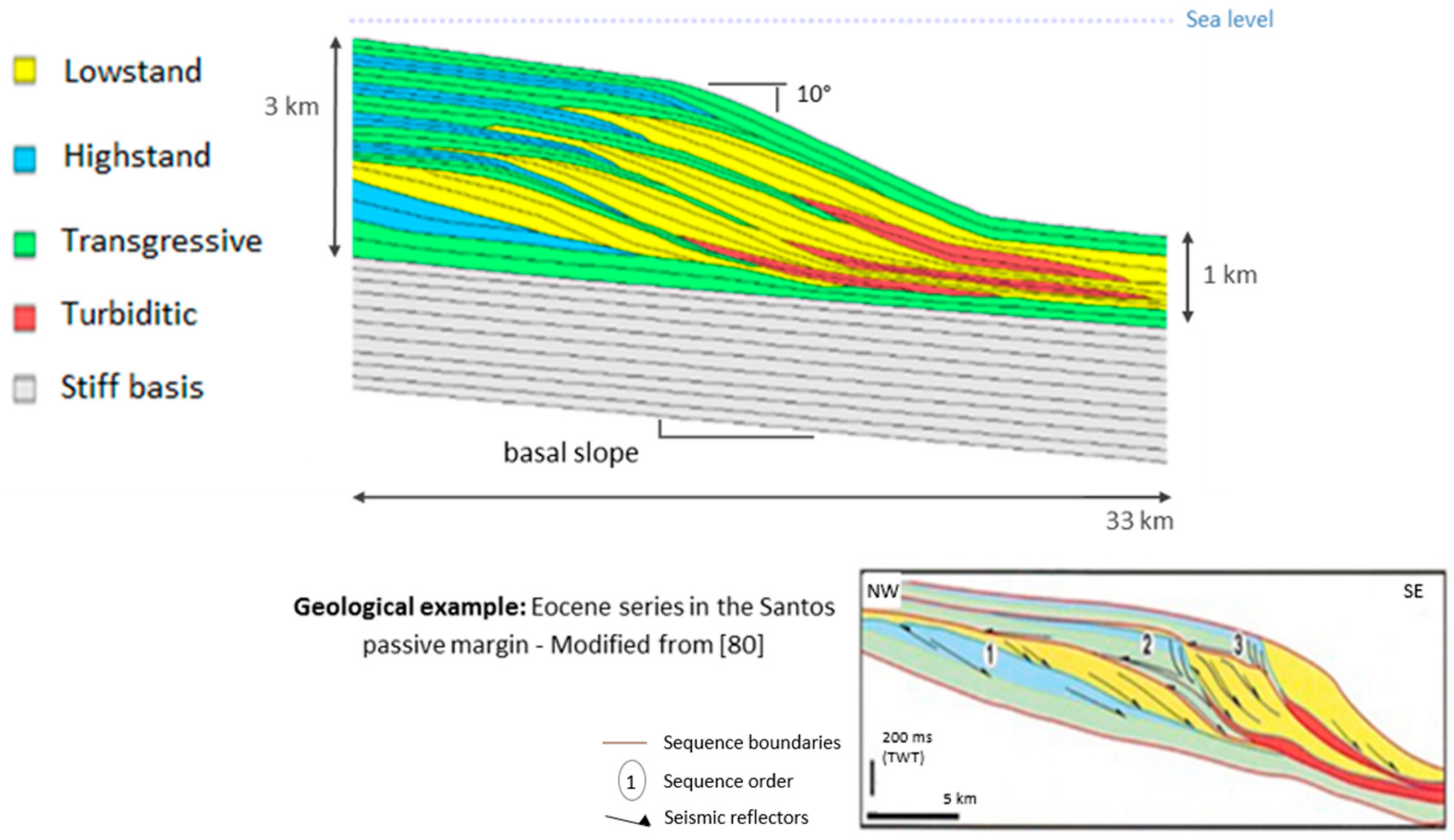

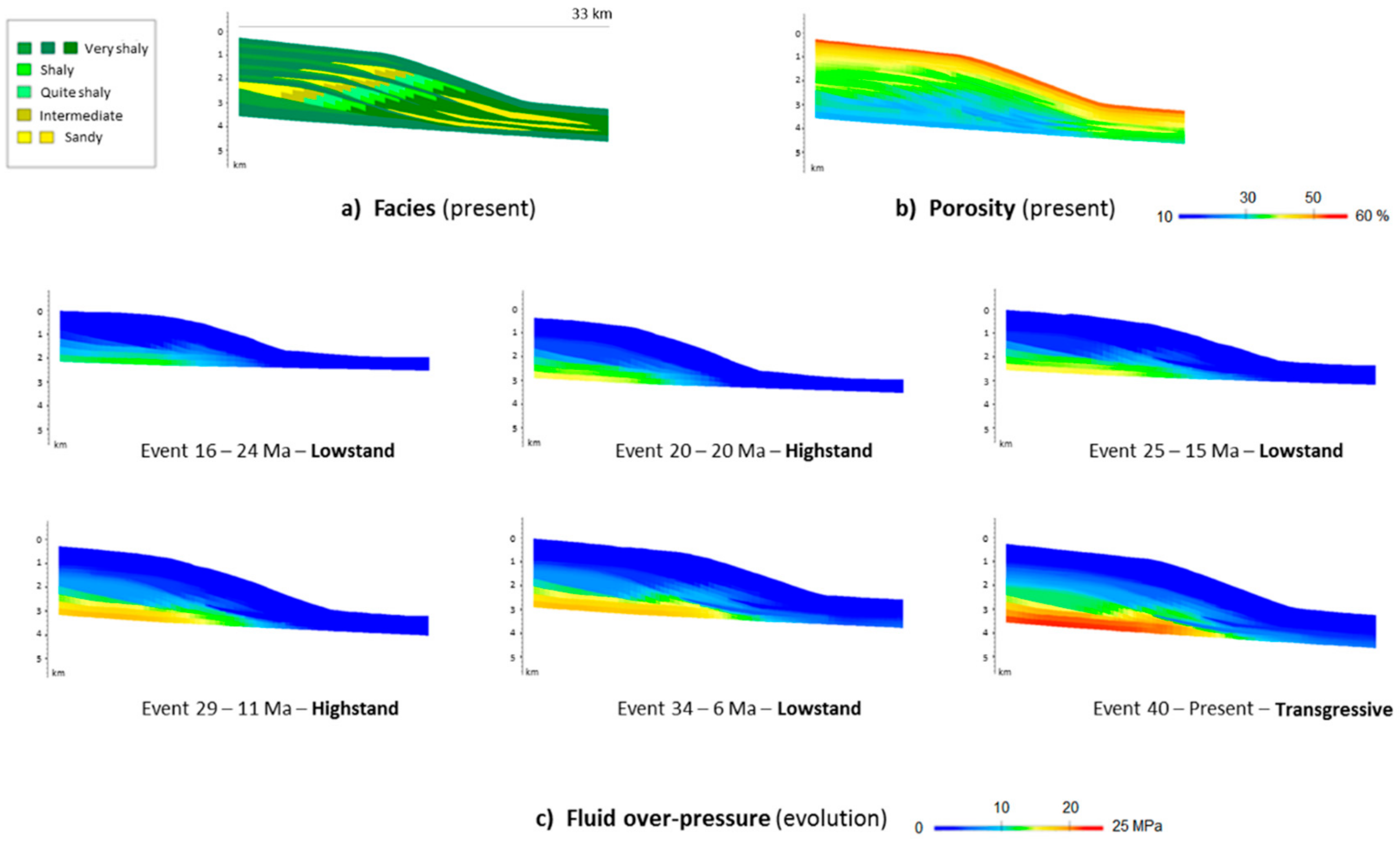
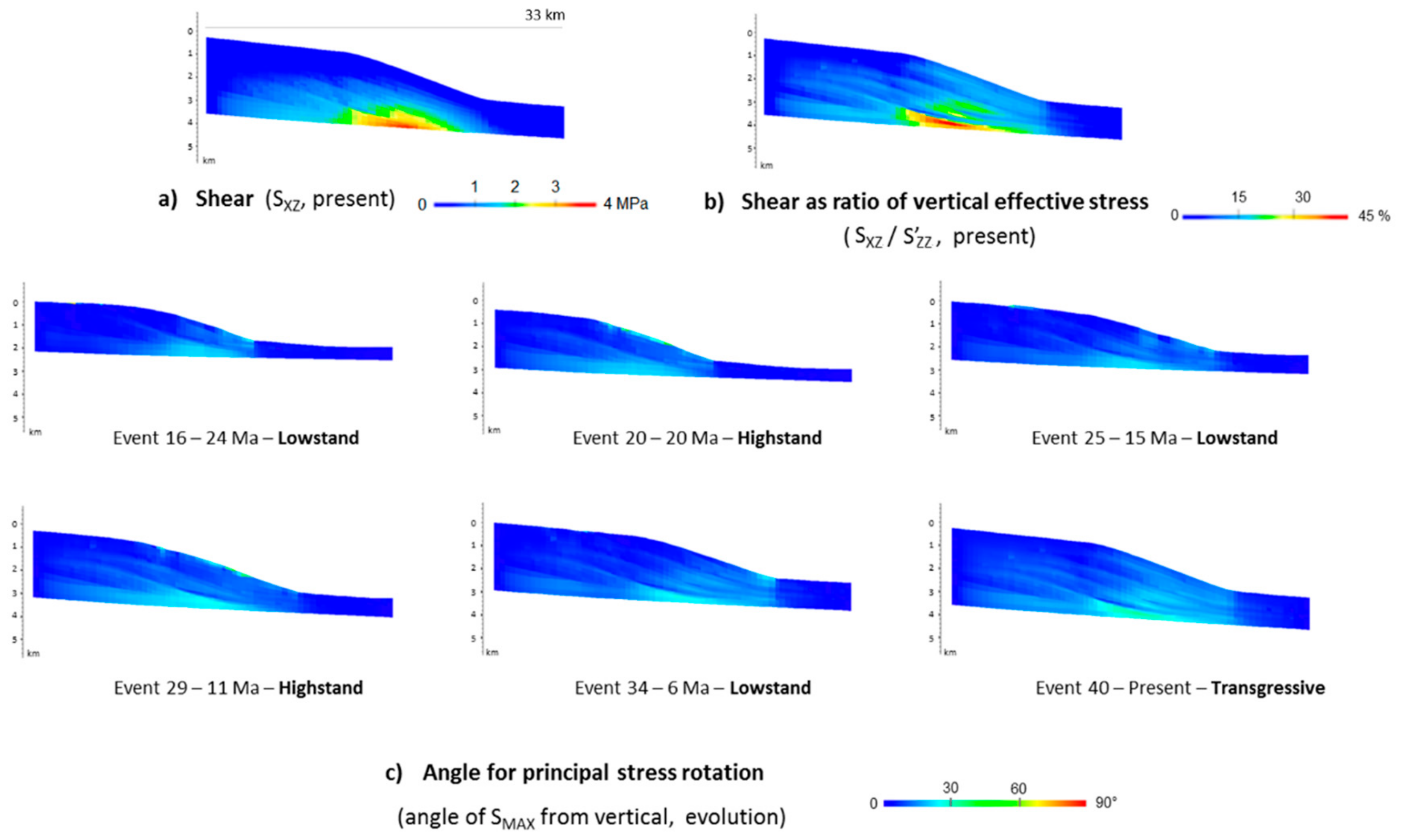
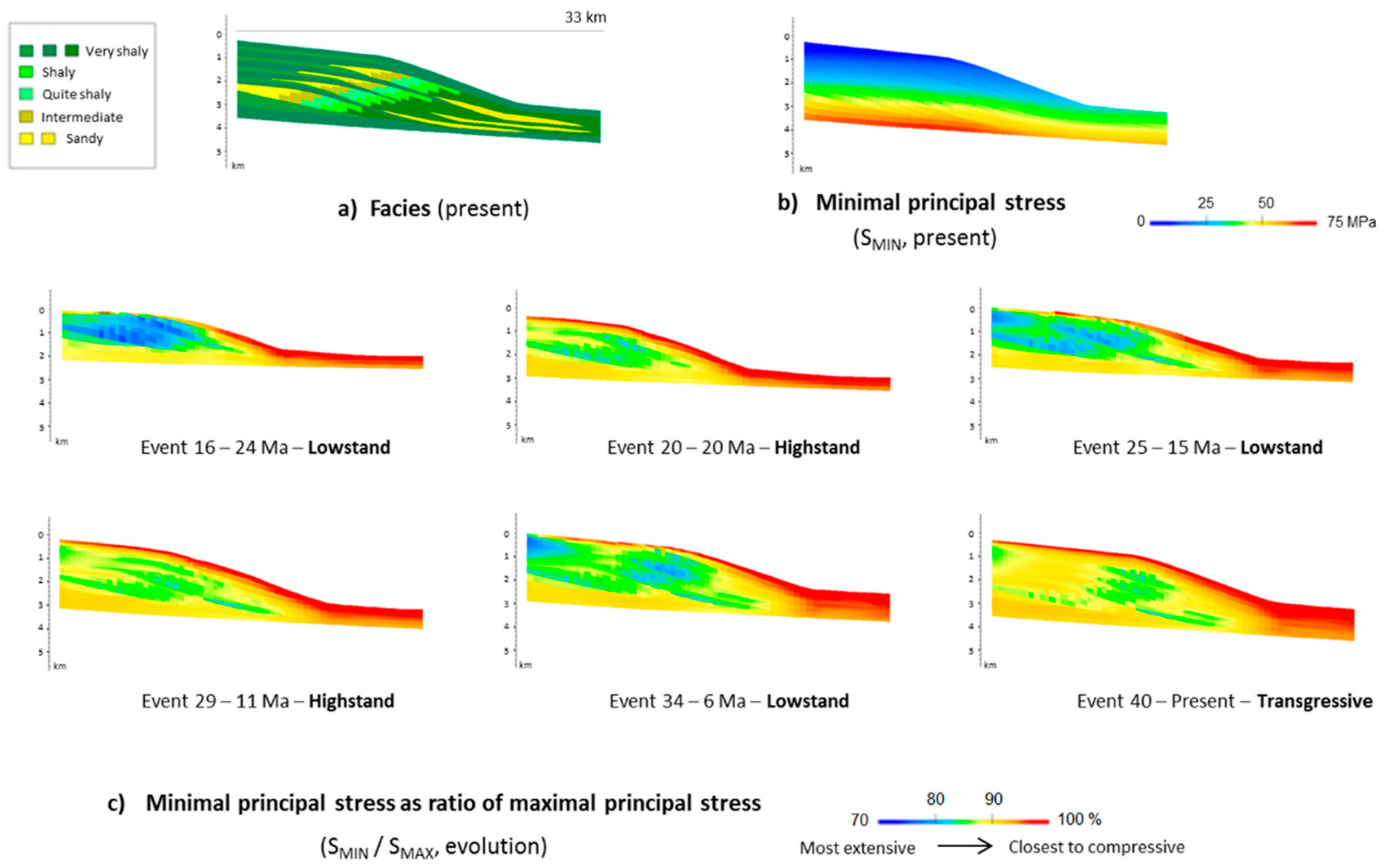
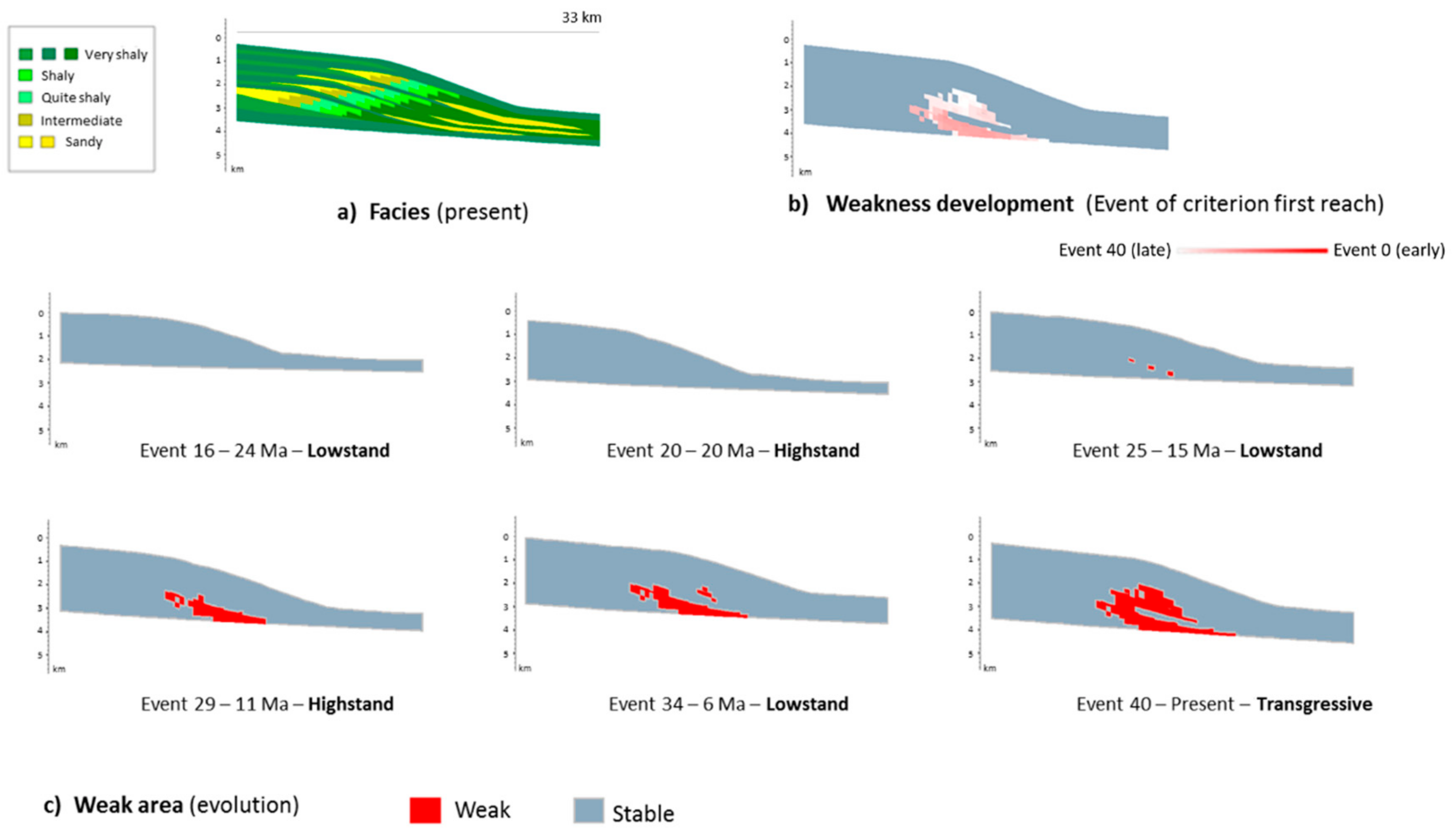
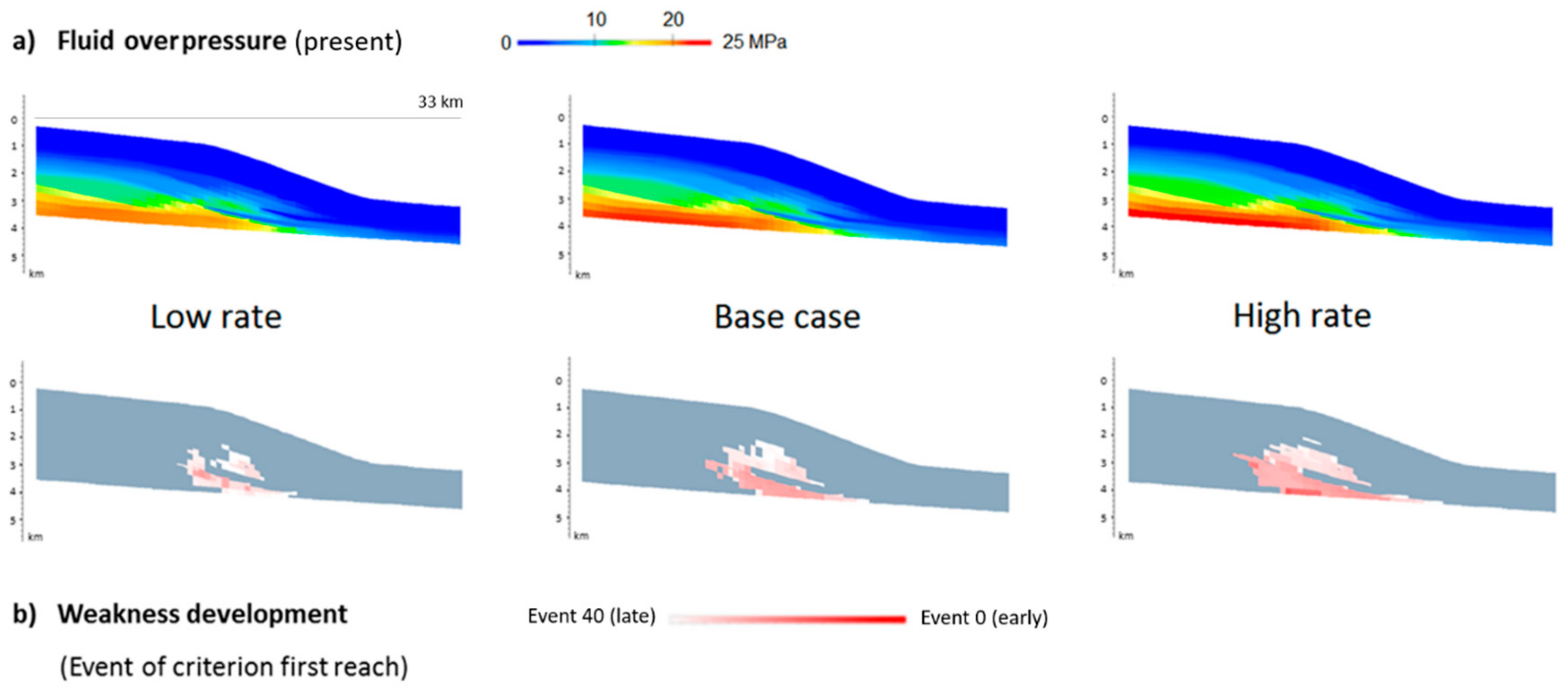
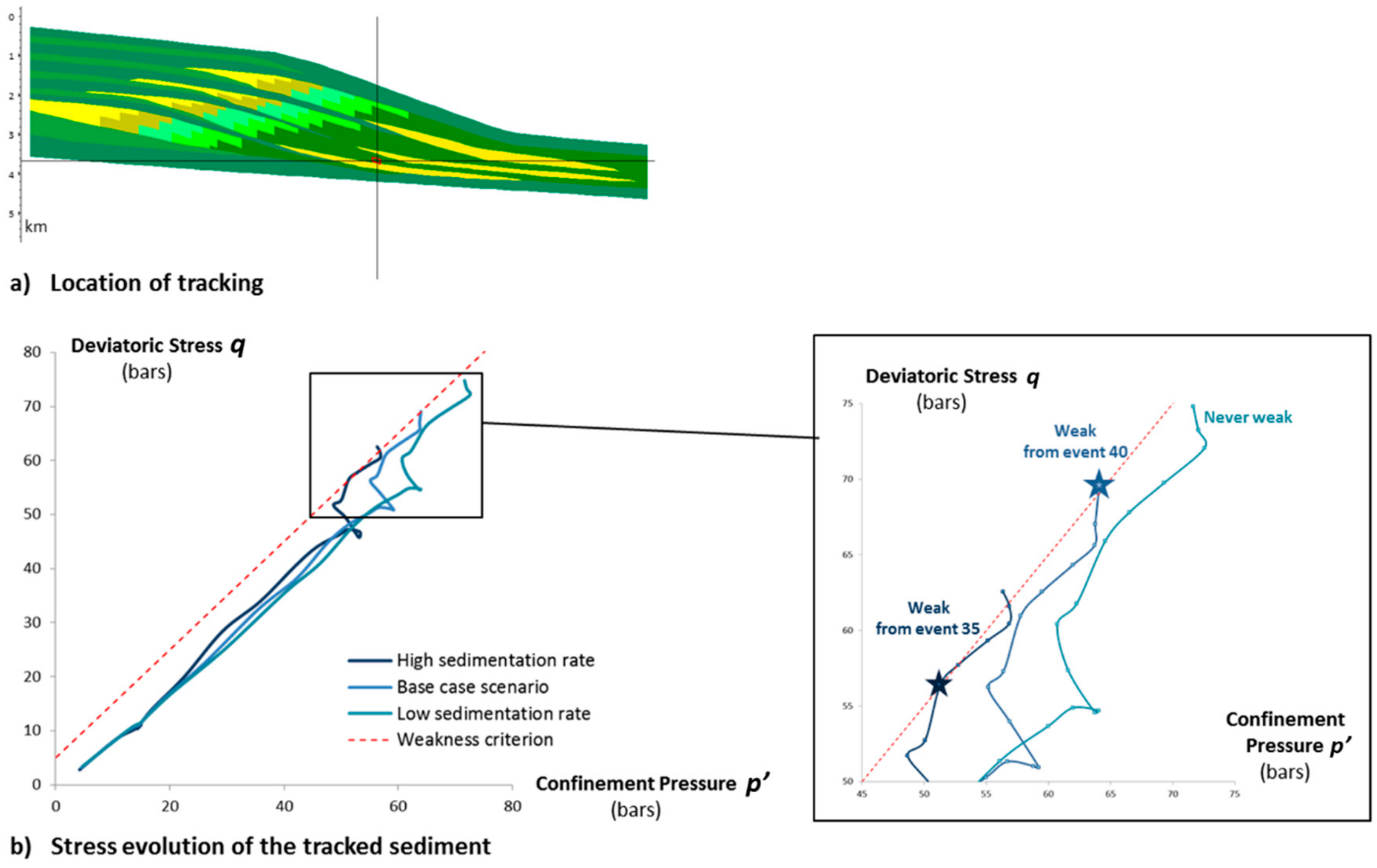
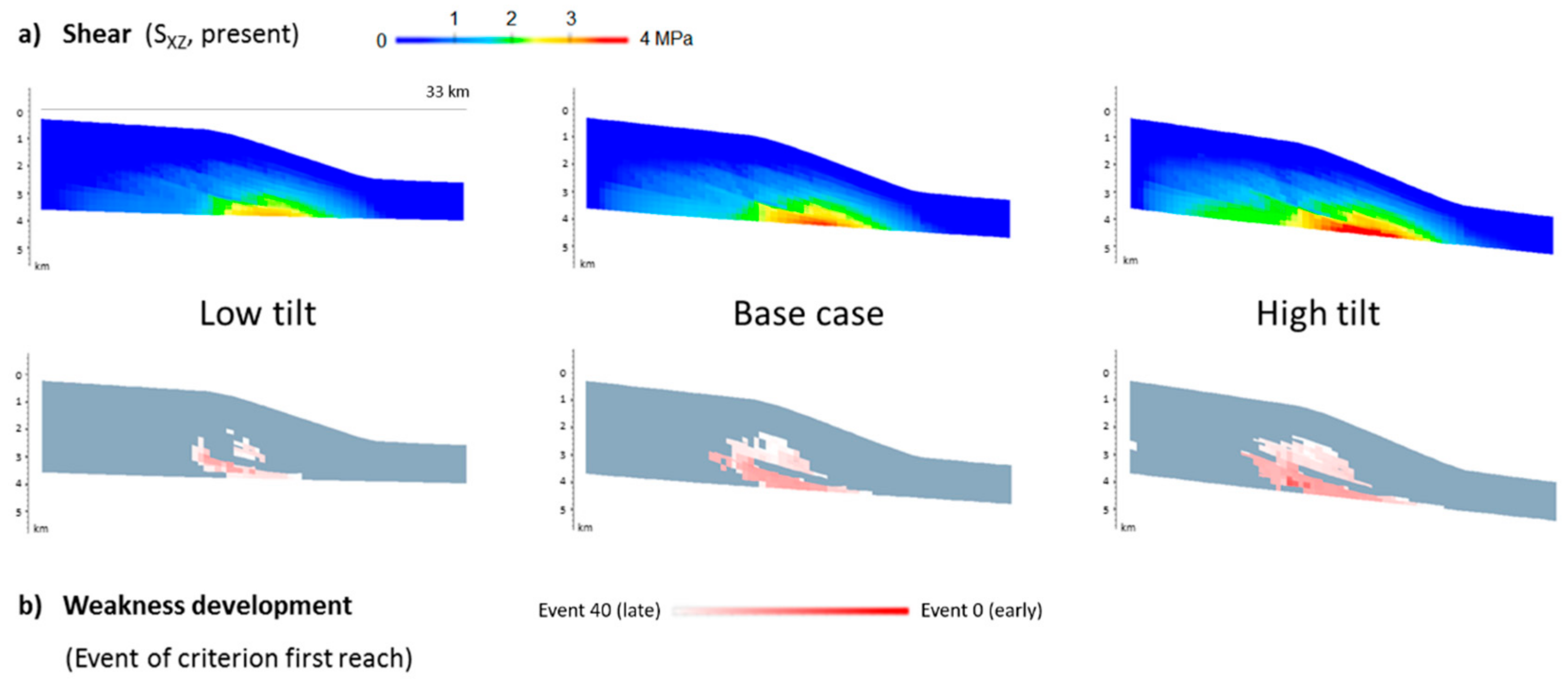
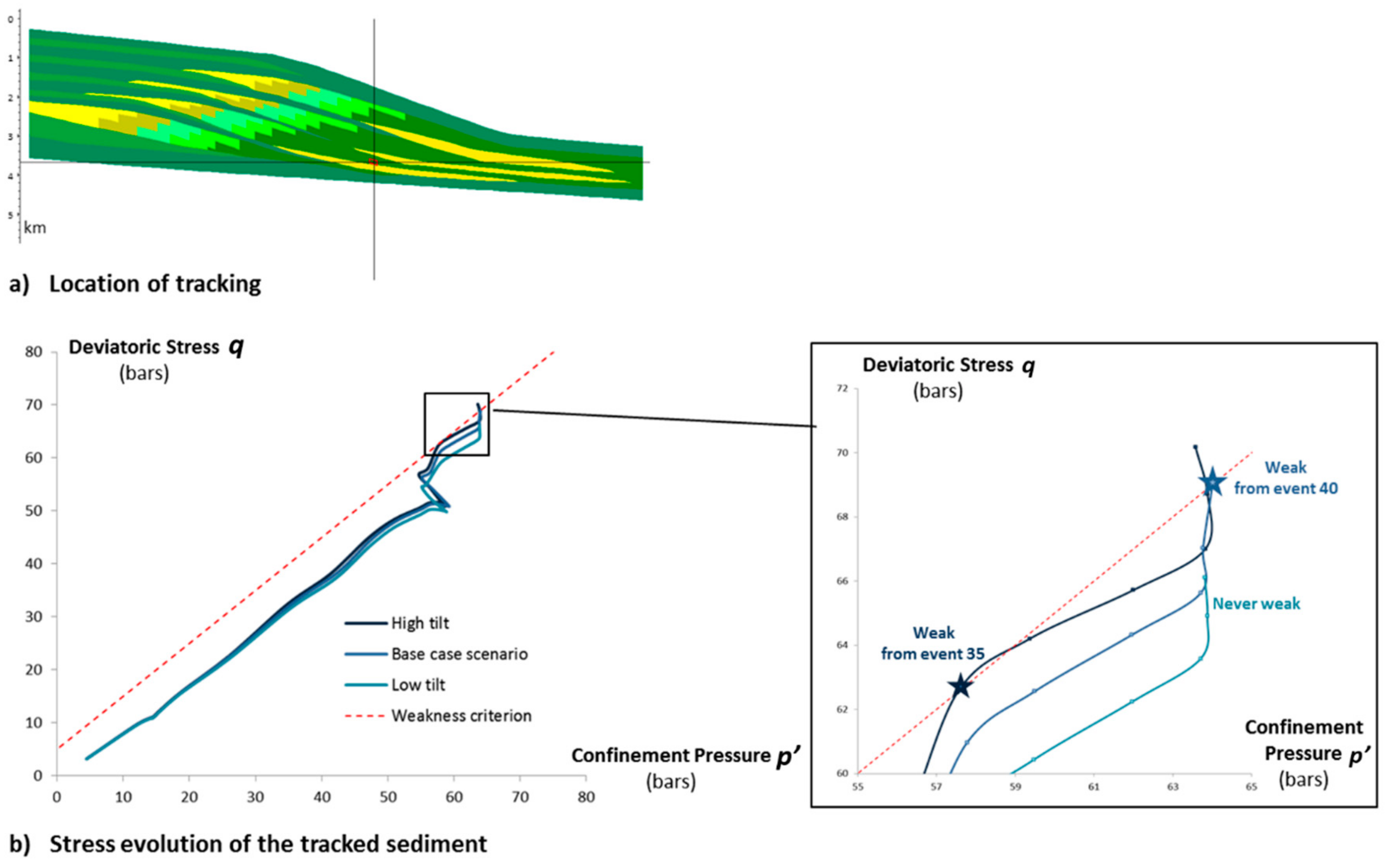
| Model | Duration of Each Event (My) | Lowest Rate (m/My) | Average Rate (m/My) | Highest Rate (m/My) |
|---|---|---|---|---|
| Low rate | 2 | 37 | 82 | 165 |
| Base case | 1 | 75 | 165 | 330 |
| High rate | 0.5 | 150 | 330 | 660 |
| Model | Initial Basal Slope | Tilt in Each Transgressive Event | Present-Day Basal Slope |
|---|---|---|---|
| Low tilt | 0° | 0.0625° | 0.75° |
| Base case | 0° | 0.125° | 1.5° |
| High tilt | 0° | 0.250° | 3° |
© 2019 by the authors. Licensee MDPI, Basel, Switzerland. This article is an open access article distributed under the terms and conditions of the Creative Commons Attribution (CC BY) license (http://creativecommons.org/licenses/by/4.0/).
Share and Cite
Bouziat, A.; Guy, N.; Frey, J.; Colombo, D.; Colin, P.; Cacas-Stentz, M.-C.; Cornu, T. An Assessment of Stress States in Passive Margin Sediments: Iterative Hydro-Mechanical Simulations on Basin Models and Implications for Rock Failure Predictions. Geosciences 2019, 9, 469. https://doi.org/10.3390/geosciences9110469
Bouziat A, Guy N, Frey J, Colombo D, Colin P, Cacas-Stentz M-C, Cornu T. An Assessment of Stress States in Passive Margin Sediments: Iterative Hydro-Mechanical Simulations on Basin Models and Implications for Rock Failure Predictions. Geosciences. 2019; 9(11):469. https://doi.org/10.3390/geosciences9110469
Chicago/Turabian StyleBouziat, Antoine, Nicolas Guy, Jérémy Frey, Daniele Colombo, Priscille Colin, Marie-Christine Cacas-Stentz, and Tristan Cornu. 2019. "An Assessment of Stress States in Passive Margin Sediments: Iterative Hydro-Mechanical Simulations on Basin Models and Implications for Rock Failure Predictions" Geosciences 9, no. 11: 469. https://doi.org/10.3390/geosciences9110469
APA StyleBouziat, A., Guy, N., Frey, J., Colombo, D., Colin, P., Cacas-Stentz, M.-C., & Cornu, T. (2019). An Assessment of Stress States in Passive Margin Sediments: Iterative Hydro-Mechanical Simulations on Basin Models and Implications for Rock Failure Predictions. Geosciences, 9(11), 469. https://doi.org/10.3390/geosciences9110469






